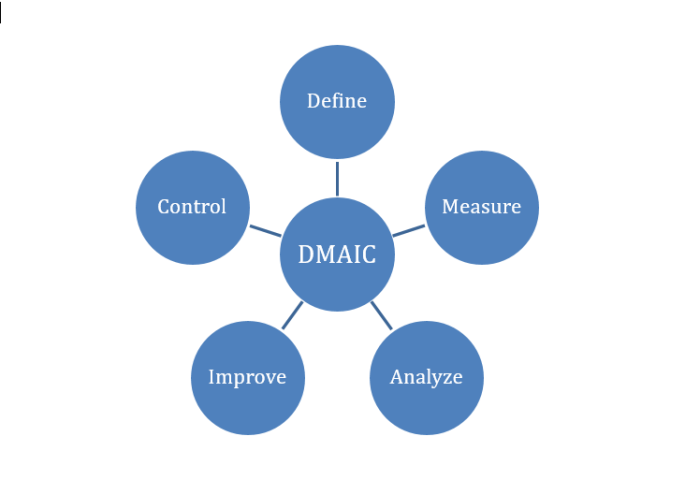
 Data Structure
Data Structure Networking
Networking RDBMS
RDBMS Operating System
Operating System Java
Java MS Excel
MS Excel iOS
iOS HTML
HTML CSS
CSS Android
Android Python
Python C Programming
C Programming C++
C++ C#
C# MongoDB
MongoDB MySQL
MySQL Javascript
Javascript PHP
PHP
- Selected Reading
- UPSC IAS Exams Notes
- Developer's Best Practices
- Questions and Answers
- Effective Resume Writing
- HR Interview Questions
- Computer Glossary
- Who is Who
The 5 Phases of Lean Sigma (DMAIC Process)

DMAIC stands for Define, Measure, Analyze, Improve, and Control - the five critical phases of Six Sigma that aim to bring efficiency to business operations. No matter the size and type of your organization, the final goal of every company is to boost its sales and profits and improve the quality of its services. With the competition growing at an exponential rate, businesses are keen on adopting any new methodology or technology that could speed up their growth.
What is the DMAIC Process?
Before getting started with Six Sigma, companies conduct an additional step called "recognize" to figure out whether DMAIC is the right approach. Even though it's not formally part of the process, it's often applied to lean Sigma because DMAIC is quite a comprehensive procedure. It is not applicable to all situations. Businesses need to carefully recognize the situation before implementing this approach. The question is, how do you decide if Lean Sigma is an appropriate choice? It depends on three crucial factors ?
You notice defects in your existing products or inefficiency in the processes.
There is room for improvement ? you can increase the profitability and reduce the cost of operation simultaneously if you adopt a different method for business operations.
You can measure the output in numbers, data, or other quantifiable terms.
You need to compare your processes with these factors to determine if you should apply DMAIC to your business and how effective the process will be.
Five Critical Phases of DMAIC
As the name suggests, the process is divided into five stages, each helping you identify your process' efficiency and suggesting the ways you can improve the outcome. Let's check out the five phases.
Define ? The first step is to identify the problems in the current processes, products, and technology. During this step, you are supposed to identify the scope of the project and how certain things might affect the stakeholders and your project's outcome. Experts also identify the areas they should improve. Once you identify the stakeholders, objectives, and potential challenges, it will be easier to proceed.
Measure ? This is where you measure the performance of the processes. In this stage, you have to think of the data collection methods to compare different processes, identify input and output indicators, analyze the current data, determine the failure rates, and use various measurement tools (charts, comparison tables, graphs, etc.) to get a clear picture of the performance metrics.
Analyze ? It's impossible to find an accurate solution to a problem when you don't look into the root cause of the issue. The third phase of the DMAIC process is about analyzing the underlying cause of the problem so that you can figure out an effective method to resolve the issue. The analysis should start with a complete root-cause analysis. Experts use a multi-vari chart to collect a visual representation of the problems in the processes. Once you are done with the analysis, you will have a clear understanding of the areas you can improve. Based on this, you can deploy an effective plan.
Improve ? This is where the magic happens. After you have identified the areas you need to improve and collected the data, the next step is to improve. Start with brainstorming ideas that can bring innovation or change to your processes. Deploy new solutions and inform stakeholders about the same. You can also use the improvement management software to streamline this part of the project management and ensure accuracy in all operations.
Control ? Once you have implemented the new processes and you see the improvement in your business performance, now is the time to think of a long-term control strategy so that your operations remain effective. You need to come up with a quality control plan to ensure your team stays on the right track and follows the same techniques.
After these five steps of the DMAIC process, you will see a change in your business operations. You can also document these changes and measure them in quantifiable terms. This includes the change in efficiency, customer satisfaction, output, cost reduction, profitability, etc.
Benefits of the DMAIC Approach
Suppose your existing processes or management operations seem ineffective, or you see scope for cost reduction and increased profit. In that case, it's always better to revisit your management strategies and identify the problems. DMAIC shows you the right way to achieve your objectives by improving the problematic areas. Along with being a simple concept, it is structured well and is quite comprehensive. You might implement as many processes as you like, but without a DMAIC approach, it's hard to keep track of the progress and problems. There's no way to figure out which process is generating results and which should be eliminated.
As it's a detailed and structured approach that requires every little detail to be documented, the DMAIC will eventually increase productivity. In addition, the data gathered during the above phases can be used to improve other processes. Teams can use this data (especially lessons learned reports) to improve their performance in current or future projects.
DMAIC vs. DMADV
DMADV is another methodology used in Six Sigma. Although both are similar on some level, the purpose of each is different. DMAIC focuses on improving profits and reducing costs by implementing the most reliable techniques or making changes in the current procedures.
DMADV, on the other hand, is concerned with designing a new product, process, or service while incorporating relevant phases ?including Define, Measure, Analyze, Design, and Verify. While DMAIC depicts specific solutions, DMADV is regarded as a part of the solution design process.
DMAIC is most suitable in areas that need improvement and where it's clear that an improvement in the processes can generate better results. DMADV is responsible for addressing the design process.
Conclusion
A successful DMAIC approach gives you a better understanding of the problems in your current approach, tools, and techniques. This helps you establish an appropriate management plan that could produce better results in the future and help you achieve your targets efficiently. It is not a one-time process but a continuous management approach that helps you reduce operating costs and increase your profit by implementing the right processes.

